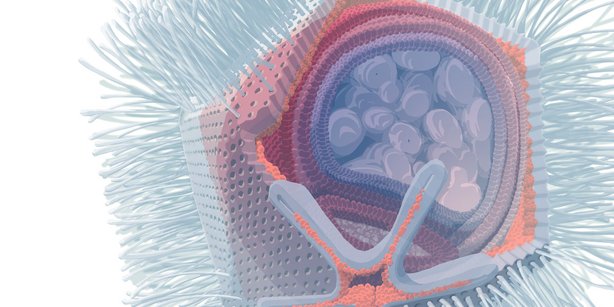Giant Viruses in the Wild

Viruses are the most abundant biological entities infecting all cellular life forms with major consequences for their individual hosts and entire…
☎ +43 1 4277 91208
✉ matthias.horn(at)univie.ac.at
» CV
» Researcher profile at the University of Vienna (u:cris)
» Lectures and courses (u:find)

Our research focuses on bacteria infecting and residing within eukaryotic cells. Using an array of molecular and computational methods, we discover novel intracellular microbes and decipher the molecular mechanisms and evolutionary processes underlying these associations.
Bacteria living within eukaryotic host cells comprise important pathogens as well as symbionts of humans, animals, and protists. Yet, intracellular microbes have long been underestimated with respect to their diversity, distribution in nature, and their ecological importance.
To address this knowledge gap, we investigate selected non-model organisms, including symbionts of amoeba, arthropods, and cnidarians, as well as viruses infecting protists. Current studies include the search for novel giant viruses, the effects of co-infections with multiple intracellular microbes, genome evolution under the constraints of the intracellular life style, and evolution experiments to better understand the evolution of microbe-host interactions.
Chlamydiae are well-known as important pathogens of humans but have more recently also been found as symbionts of free-living amoebae. Molecular surveys suggest that the chlamydiae are highly diverse, likely infecting almost any animal lineage. They represent one of the evolutionary oldest strictly intracellular groups of microbes, with their last common ancestor having lived around one billion years ago. Studying chlamydial symbionts such as Protochlamydia amoebophila and Parachlamydia acanthamoebae, the comparison with their pathogenic counterparts, as well as evolution experiments using these symbionts allow us to investigate the evolution of the intracellular lifestyle of chlamydiae and their adaptation to different eukaryotic hosts. This research is carried out within the group of Matthias Horn, together with Astrid Collingro.
Recent project: Chlamydial symbionts in dictyostelids
The soil amoeba Dictyostelium discoideum is one of the best-known protist model systems and famous for its so-called social life cycle, a conserved mechanism found in all dictyostelids. During this life cycle, tens of thousands of cells aggregate and develop multicellular structures, eventually leading to the formation of spores. Recent evidence suggests that in nature chlamydial symbionts are widespread among dictyostelids. In this project, we aim to understand the diversity of chlamydial symbionts in dictyostelids and ask how chlamydiae adapted to the specific social life cycle of dictyostelid amoebae.
Collaboration partners:Susanne DiSalvo (Southern Illinois University Edwardsville), Tamara Haselkorn (University of Central Arkansas), Thiery Soldati (University of Geneva).

Viruses are the most abundant biological entities infecting all cellular life forms with major consequences for their individual hosts and entire ecosystems. Yet, they are also the most unknown biological players, with the protist-infecting nucleocytoplasmic large DNA viruses (Nucleocytoviricota), also referred to as giant viruses, as one of the more recent discoveries that challenged our perception of the viral world.
Giant viruses are as large as bacteria both in terms of particle and genome size, and share a number of features previously observed in cellular microorganisms only. Our current knowledge about these unusual viruses is predominantly based on few isolates obtained with a very limited number of protist host species, while metagenomic data suggests a tremendous diversity of yet undiscovered viruses infecting microbial eukaryotes.
We participated in the discovery of the Klosneuvirinae, a group of giant viruses with a record-holding large number of translation-related genes. More recently, we have shown how bacterial symbionts help amoeba hosts to counter infections by giant viruses, representing one of the very few giant virus defense mechanisms in protists.

Many protists harbor specific bacterial symbionts. The function of these symbionts is, however, mostly unknown, and so are the underlying mechanisms of host interactions.
We are using diverse model systems to better understand the role of microbial symbionts for their protist hosts. We have shown that chlamydial symbionts can protect amoeba from lethal infections with the bacterial pathogen Legionella pneumoniae, and we have described an unusual protein secretion system in the amoeba symbiont Amoebophilus asiaticus.
We study amoeba symbionts such as Nucleicultrix amoebiphila to better understand how bacteria target and replicate in the nucleus of their host cells.

Arthropods and their bacterial symbionts represent well-known models for studying microbial symbiosis and the interaction between microbes and animal. In our lab, we are particularly interested in the less well studied microbial symbionts and arthropod groups and have investigated bacterial symbionts in the wood louse Porcellio scaber, the dwarf spider Oedothorax gibbosus, mealybugs, and adelgids of the Adelges laricis/Adelges tardus species complex. This research is carried out in parts in collaboration with Alejandro Manzano Marín.


Viruses are the most abundant biological entities infecting all cellular life forms with major consequences for their individual hosts and entire…

Bacterial pathogens are generally investigated in the context of diseases. Their environmental lifestyle and reservoirs are often neglected. This…

Free-living amoebae are ubiquitous, they feed on other microbes and shape microbial communities. They also serve as transient hosts for facultative…

Many intracellular bacteria rely on an extracellular stage to move between hosts – but what happens when that’s no longer needed? A new study, now…

The single-celled organism Naegleria fowleri ranks among the deadliest human parasites. Researchers around Matthias Horn and Patrick Arthofer from…

Chlamydiae is known for the infamous human pathogen Chlamydia, but this group of bacteria evolved over a billion years ago. Despite being ancient and…
Helmlinger L, Arthofer P, Cyran N, Collingro A, Horn M. The adaptation of chlamydiae to facultative host multicellularity. Current Biology. 2025 Jul 21;35(14):3368-3380.e4. doi: 10.1016/j.cub.2025.06.014
Mayer L, Nikolov G, Kunert M, Horn M, Willemsen A. Mimivirus transcription and translation occur at well-defined locations within amoeba host cells. Journal of Virology. 2025 Jun 13;99(7):e00554-25. doi: 10.1128/jvi.00554-25
Willemsen A, Manzano-Marín A, Horn M. Novel high-quality amoeba genomes reveal widespread codon usage mismatch between giant viruses and their hosts. Genome Biology and Evolution. 2025 Jan 6;17(1):evae271. doi: 10.1101/2024.09.23.614596, 10.1093/gbe/evae271
Arthofer P, Panhölzl F, Delafont V, Hay A, Reipert S, Cyran N et al. A giant virus infecting the amoeboflagellate Naegleria. Nature Communications. 2024 Dec;15(1):3307. Epub 2024 Apr 24. doi: 10.1038/s41467-024-47308-2
Maire J, Collingro A, Horn M, van Oppen MJH. Chlamydiae in corals: shared functional potential despite broad taxonomic diversity. ISME Communications. 2024 Apr 15;4(1):ycae054. doi: 10.1093/ismeco/ycae054
Matthias Horn is part of the FWF-funded Cluster of Excellence (CoE)

